Flood Susceptibility and Sediment Transport Analysis of Stromboli Island after the 3 July 2019 Paroxysmal Explosion
Abstract
1. Introduction
2. Material and Methods
2.1. Slope Instability and Material Properties at Stromboli Island
- Lava unit (L): alternation of lava layers (more than 65%) and autoclastic breccia layers;
- Lava-Breccia unit (LB): alternation of lava layers (ranging from 35–65%) and breccia layers;
- Breccia unit (B): alternation of lava layers (less than 35%) and autoclastic breccia layers;
- Pyroclastic deposits (P) (poorly welded): prevailing pyroclastic breccias alternating with tuff and lapillistones.
2.2. Hydrological Study for the Estimation of Flood Discharges
2.3. Flood Model with the Software IBER
2.4. Sediment Transport Model with the Software IBER
3. Results
3.1. Flood Discharge and Hazard Assessment
3.2. Sediment Erosion and Deposition
4. Discussion
5. Conclusions
Author Contributions
Funding
Acknowledgments
Conflicts of Interest
References
- Pierson, T.C.; Scott, K.M. Downstream dilution of a lahar: Transition from debris flow to hyperconcentrated streamflow. Water Resour. Res. 1985, 21, 1511–1524. [Google Scholar] [CrossRef]
- Bisson, M.; Pareschi, M.T.; Zanchetta, G.; Supizio, R.; Santacroce, R. Volcaniclastic debris-flow occurrences in the Campania region (Southern Italy) and their relation to Holocene-Late Pleistocene pyroclastic fall deposits: Implications for large-scale hazard mapping. Bull. Volcanol. 2007, 70, 157–167. [Google Scholar] [CrossRef]
- Pierson, T.C.; Major, J.J. Hydrogeomorphic effects of explosive volcanic eruptions on drainage basins. Annu. Rev. Earth Planet. Sci. 2014, 42, 469–507. [Google Scholar] [CrossRef]
- Gran, K.B.; Montgomery, D.R. Spatial and temporal patterns in fluvial recovery following volcanic eruptions: Channei response to basin-wide sediment loading at Mount Pinatubo, Philippines. Geol. Soc. Am. Bull. 2005, 117, 195–211. [Google Scholar] [CrossRef]
- Major, J.J.; Mark, L.E. Peak flow responses to landscape disturbances caused by the cataclysmic 1980 eruption of Mount St. Helens, Washington. Geol. Soc. Am. Bull. 2006, 118, 938–958. [Google Scholar] [CrossRef]
- Panagoulia, D.; Zarris, D.; Maggina, K. An Assessment of the Interaction Between Storm Events and Sediment Transport. In Proceedings of the 5th International Synposium on Ecohydraulics, Aguatic Habitats: Analysis & Restoration, Madrid, Spain, 12–17 September 2004; pp. 281–286. [Google Scholar]
- Son, J.H.; Kim, S.; Carlson, K.H. Effects of wildfire on river water quality and riverbed sediment phosphorus. Water Air Soil Pollut. 2015, 226, 26. [Google Scholar] [CrossRef]
- Malmon, D.V.; Reneau, S.L.; Katzman, D.; Lavine, A.; Lyman, J. Suspended sediment transport in an ephemeral stream following wildfire. J. Geophys. Res. Earth Surf. 2007, 112, 1–16. [Google Scholar] [CrossRef]
- Major, J.; Bertin, D.; Pierson, T.C.; Amigo, Á.; Iroumé, A.; Ulloa, H.; Castro, J. Extraordinary sediment delivery and rapid geomorphic response following the 2008–2009 eruption of Chaitén Volcano, Chile. Water Resour. Res. 2016, 52, 5075–5094. [Google Scholar] [CrossRef]
- Jones, R.; Thomas, R.E.; Peakall, J.; Manville, V. Rainfall-runoff properties of tephra: Simulated effects of grain-size and antecedent rainfall. Geomorphology 2017, 282, 39–51. [Google Scholar] [CrossRef]
- Branca, S. Geological and geomorphological evolution of the Etna volcano NE flank and relationships between lava flow invasions and erosional processes in the Alcantara Valley (Italy). Geomorphology 2003, 53, 147–161. [Google Scholar] [CrossRef]
- Rhoades, C.C.; Entwistle, D.; Butler, D. The influence of wildfire extent and severity on streamwater chemistry, sediment and temperature following the Hayman Fire, Colorado. Int. J. Wild. Fire 2011, 20, 430–442. [Google Scholar] [CrossRef]
- Warrick, J.A.; Hatten, J.A.; Pasternack, G.B.; Gray, A.B.; Goni, M.A.; Wheatcroft, R.A. The effects of wildfire on the sediment yield of a coastal California watershed. Bull. Geol. Soc. Am. 2012, 124, 1130–1146. [Google Scholar] [CrossRef]
- Lane, P.N.; Sheridan, G.J.; Noske, P.J. Changes in sediment loads and discharge from small mountain catchments following wildfire in south eastern Australia. J. Hydrol. 2006, 331, 495–510. [Google Scholar] [CrossRef]
- Parise, M.; Cannon, S.H. Wildfire impacts on the processes that generate debris flows in burned watersheds. Nat. Haz. 2012, 61, 217–227. [Google Scholar] [CrossRef]
- Major, J.J. Post-eruption hydrology and sediment transport in volcanic river systems. Water Resour. Impact 2003, 5, 10–15. [Google Scholar]
- Cannon, S.H.; Reneau, S.L. Conditions for generation of fire-related debris flows, Capulin Canyon, New Mexico. Earth Surf. Process. Landforms 2000, 25, 1103–1121. [Google Scholar] [CrossRef]
- Cannon, S.H.; Gartner, J.E. Wildfire-related debris flow from a hazards perspective. In Debris-fLow Hazards and Related Phenomena; Springer: Berlin/Heidelberg, Germany, 2005; pp. 363–385. [Google Scholar]
- Panagoulia, D. Hydrological modeling of a medium-size mountainous catchment from incomplete meteorological data. J. Hydrol. 1992, 137, 279–310. [Google Scholar] [CrossRef]
- Ortíz-Rodríguez, A.J.; Muñoz-Robles, C.; Borselli, L. Changes in connectivity and hydrological efficiency following wildland fires in Sierra Madre Oriental, Mexico. Sci. Total Environ. 2019, 655, 112–128. [Google Scholar] [CrossRef]
- Barberi, F.; Rosi, M.; Sodi, A. Volcanic hazard assessment at Stromboli based on review of historical data. Acta Vulcanol. 1993, 3, 173–187. [Google Scholar]
- Blackbum, E.A.; Wilson, L.; Sparks, R.J. Mechanisms and dynamics of strombolian activity. J. Geol. Soc. 1976, 132, 429–440. [Google Scholar] [CrossRef]
- Calvari, S.; Bonaccorso, A.; Madonia, P.; Neri, M.; Liuzzo, M.; Salerno, G.G.; Behncke, B.; Caltabiano, T.; Cristaldi, A.; Giuffrida, G.; et al. Major eruptive style changes induced by structural modifications of a shallow conduit system: The 2007–2012 Stromboli case. Bull. Volcanol. 2014, 76, 841. [Google Scholar] [CrossRef]
- Calvari, S.; Spampinato, L.; Lodato, L.; Harris, A.J.; Patrick, M.R.; Dehn, J.; Burton, M.; Andronico, D. Chronology and complex volcanic processes during the 2002–2003 flank eruption at Stromboli volcano (Italy) reconstructed from direct observations and surveys with a handheld thermal camera. J. Geophys. Res. Solid Earth 2005, 110. [Google Scholar] [CrossRef]
- Calvari, S.; Lodato, L.; Steffke, A.; Cristaldi, A.; Harris, A.J.L.; Spampinato, L.; Boschi, E. The 2007 Stromboli flank eruption: Chronology of the events, and effusion rate measurements from thermal images and satellite data. J. Geophys. Res. Solid Earth 2010, 115, B04201. [Google Scholar] [CrossRef]
- Di Traglia, F.; Calvari, S.; D’Auria, L.; Nolesini, T.; Bonaccorso, A.; Fornaciai, A.; Esposito, A.; Cristaldi, A.; Favalli, M.; Casagli, N. The 2014 effusive eruption at Stromboli: New insights from in situ and remote-sensing measurements. Remote Sens. 2018, 10, 2035. [Google Scholar] [CrossRef]
- Plank, S.; Marchese, F.; Filizzola, C.; Pergola, N.; Neri, M.; Nolde, M.; Martinis, S. The July/August 2019 Lava Flows at the Sciara del Fuoco, Stromboli–Analysis from Multi-Sensor Infrared Satellite Imagery. Remote Sens. 2019, 11, 2879. [Google Scholar] [CrossRef]
- Turchi, A.; Di Traglia, F.; Luti, T.; Olori, D.; Zetti, I.; Fanti, R. Environmental Aftermath of the 2019 Stromboli Eruption. Remote Sens. 2020, 12, 994. [Google Scholar] [CrossRef]
- Bladé, E.; Cea, L.; Corestein, G.; Escolano, E.; Puertas, J.; Vázquez-Cendón, J.; Dolz, J.; Coll, A. IBER: Herramienta de simulación numérica de flujo en ríos. Rev. Int. Métodos Numéricos Para Cálculo Diseño Ing. 2014, 30, 1–10. [Google Scholar] [CrossRef]
- Apuani, T.; Corazzato, C.; Cancelli, A.; Tibaldi, A. Physical and mechanical properties of rock masses at Stromboli: A dataset for volcano instability evaluation. Bull. Eng. Geol. Environ. 2005, 64, 419. [Google Scholar] [CrossRef]
- Boldini, D.; Wang, F.; Sassa, K.; Tommasi, P. Application of large-scale ring shear tests to the analysis of tsunamigenic landslides at the Stromboli volcano, Italy. Landslide 2009, 6, 231–240. [Google Scholar] [CrossRef][Green Version]
- Rotonda, T.; Tommasi, P.; Boldini, D. Geomechanical characterization of the volcaniclastic material involved in the 2002 landslides at Stromboli. J. Geotech. Geoenviron. Eng. 2010, 136, 389–401. [Google Scholar] [CrossRef]
- Nolesini, T.; Di Traglia, F.; Del Ventisette, C.; Moretti, S.; Casagli, N. Deformations and slope instability on Stromboli volcano: Integration of GBInSAR data and analog modeling. Geomorphology 2013, 180, 242–254. [Google Scholar] [CrossRef]
- International Society for Rock Mechanics. Rock Characterization Testing & [and] Monitoring: ISRM Suggested Methods; Pergamon Press: Oxford, UK, 1981. [Google Scholar]
- Hoek, E.; Carranza-Torres, C.; Corkum, B. Hoek-Brown failure criterion-2002 edition. Proc. NARMS-Tac 2002, 1, 267–273. [Google Scholar]
- Apuani, T.; Corazzato, C.; Cancelli, A.; Tibaldi, A. Stability of a collapsing volcano (Stromboli, Italy): Limit equilibrium analysis and numerical modelling. J. Volcanol. Geotherm. Res. 2005, 144, 191–210. [Google Scholar] [CrossRef]
- Corazzato, C.; Francalanci, L.; Menna, M.; Petrone, C.M.; Renzulli, A.; Tibaldi, A.; Vezzoli, L. What controls sheet intrusion in volcanoes? Structure and petrology of the Stromboli sheet complex, Italy. J. Volcanol. Geotherm. Res. 2008, 173, 26–54. [Google Scholar] [CrossRef]
- Casagli, N.; Tibaldi, A.; Merri, A.; Del Ventisette, C.; Apuani, T.; Guerri, L.; Fortuny-Guasch, J.; Tarchi, D. Deformation of Stromboli Volcano (Italy) during the 2007 eruption revealed by radar interferometry, numerical modelling and structural geological field data. J. Volcanol. Geotherm. Res. 2009, 182, 182–200. [Google Scholar] [CrossRef]
- Bartolini, S.; Cappello, A.; Martí, J.; Del Negro, C. QVAST: A new Quantum GIS plugin for estimating volcanic susceptibility. Nat. Hazards Earth Syst. Sci. 2013, 13, 3031–3042. [Google Scholar] [CrossRef]
- Di Traglia, F.; Bartolini, S.; Artesi, E.; Nolesini, T.; Ciampalini, A.; Lagomarsino, D.; Martí, J.; Casagli, N. Susceptibility of intrusion-related landslides at volcanic islands: The Stromboli case study. Landslides 2018, 15, 21–29. [Google Scholar] [CrossRef]
- Del Soldato, M.; Segoni, S.; De Vita, P.; Pazzi, V.; Tofani, V.; Moretti, S. Thickness model of pyroclastic soils along mountain slopes of Campania (southern Italy). In Landslides and Engineered Slopes. Experience, Theory and Practice; Associazione Geotecnica Italaiana: Rome, Italy, 2016. [Google Scholar]
- Del Soldato, M.; Pazzi, V.; Segoni, S.; De Vita, P.; Tofani, V.; Moretti, S. Spatial modeling of pyroclastic cover deposit thickness (depth to bedrock) in peri-volcanic areas of Campania (southern Italy). Earth Surf. Process. Landforms 2018, 43, 1757–1767. [Google Scholar] [CrossRef]
- Lucchesi, T.; Arnone, G. Relazione Generale. In Piano Stralcio di Bacino per l’Assetto Idrogeologico della Regione Siciliana; Assessorato Territorio e Ambiente Dipartimento Territorio e Ambiente: Regione Siciliana, Italy, 2004; pp. 1–183. [Google Scholar]
- Chen, I. Rainfall intensity-duration-frequency formulas. J. Hydraul. Eng. 1983, 109, 1603. [Google Scholar] [CrossRef]
- Bladé, E.; Cea, L.; Corestein, G. Modelización numérica de inundaciones fluviales. Ing. Del Agua 2014, 18, 71–82. [Google Scholar]
- Bonasia, R.; Areu-Rangel, O.S.; Tolentino, D.; Mendoza-Sanchez, I.; González-Cao, J.; Klapp, J. Flooding hazard assessment at Tulancingo (Hidalgo, Mexico). J. Flood Risk Manag. 2014, 11, S1116–S1124. [Google Scholar] [CrossRef]
- Areu-Rangel, O.S.; Cea, L.; Bonasia, R.; Espinosa-Echavarria, V.J. Impact of urban growth and changes in land use on river flood hazard in Villahermosa, Tabasco (Mexico). Water 2019, 11, 304. [Google Scholar] [CrossRef]
- Chiew, Y.M.; Parker, G. Incipient motion on non-horizontal slopes. Jou Hydraul. Res. 1994, 32, 649–660. [Google Scholar] [CrossRef]
- Meyer-Peter, E.; Müller, R. Formulas for bedload transport. In Proceedings of the 2nd Congress, IAHR, Stockholm, Sweden, 7–9 June 1948; pp. 39–64. [Google Scholar]
- Van Rijn, L.C. Mathematical Modelling of Morphological Processes in the Case of Suspended Sediment Transport. 1987. Available online: https://pdfs.semanticscholar.org/551e/4a238e9fa0651c5e44558c27f7a56d490aee.pdf (accessed on 17 April 2020).
- Pinto, L.; Fortunato, A.B.; Freire, P. Sensitivity analysis of non-cohesive sediment transport formulae. Cont. Shelf Res. 2006, 26, 1826–1839. [Google Scholar] [CrossRef]
- Wong, M. Does the Bedload Equation of Meyer-Peter and Mu¨ller Fit Its Own Data? International Association of Hydraulic Research: Thessaloniki, Greece, 2003; pp. 73–80. [Google Scholar]
- Wong, M.; Parker, G. Reanalysis and Correction of Bed-Load Relation of Meyer-Peter and Müller Using Their Own Database. J. Hydraul. Eng. 2006, 132, 1159–1168. [Google Scholar] [CrossRef]
- Apsley, D.D.; Stansby, P.K. Bed-Load Sediment Transport on Large Slopes: Model Formulation and Implementation with a RANS Solver. J. Hydraul. Eng. ASCE 2008, 134, 1440–1451. [Google Scholar] [CrossRef]
- Verrucci, L.; Tommasi, P.; Boldini, D.; Graziani, A.; Rotonda, T. Modeling the instability phenomena on the NW flank of Stromboli Volcano (Italy) due to lateral dyke intrusion. J. Volcanol. Geoth. Res. 2019, 371, 245–262. [Google Scholar] [CrossRef]
- Neary, D.G.; Ryan, K.C.; DeBano, L.F. Wildland fire in ecosystems: Effects of fires on soils and water. In General Technical Report RMRS-GTR-41-vol.4; USDA, Forest Service, Rocky Mountain Research Station: Ogden, UT, USA, 2005. [Google Scholar]
- Ebel, B.A.; Mirus, B.B. Disturbance hydrology: Challenges and opportunities. Hydrol. Process 2014, 28, 5140–5148. [Google Scholar] [CrossRef]
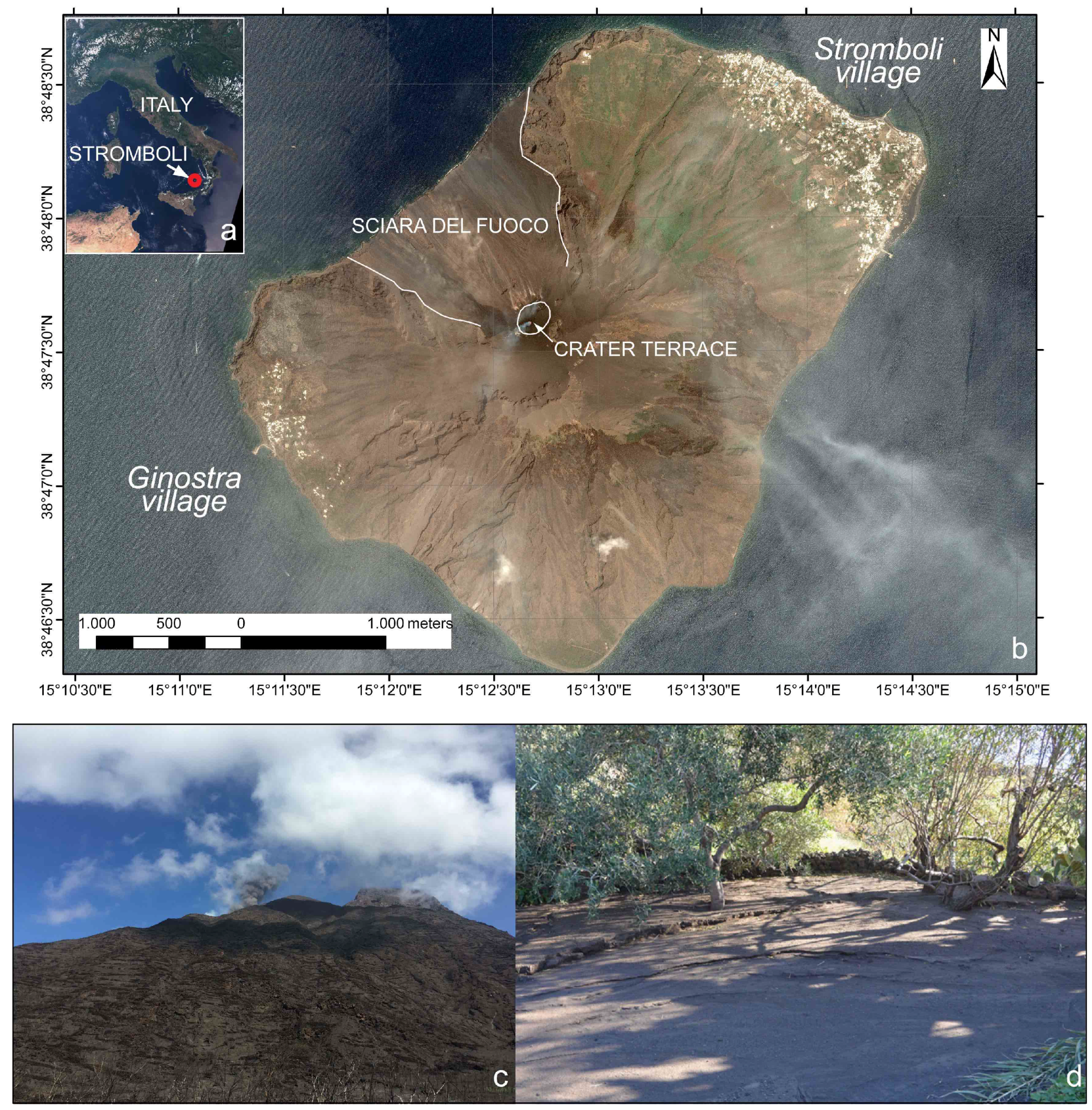
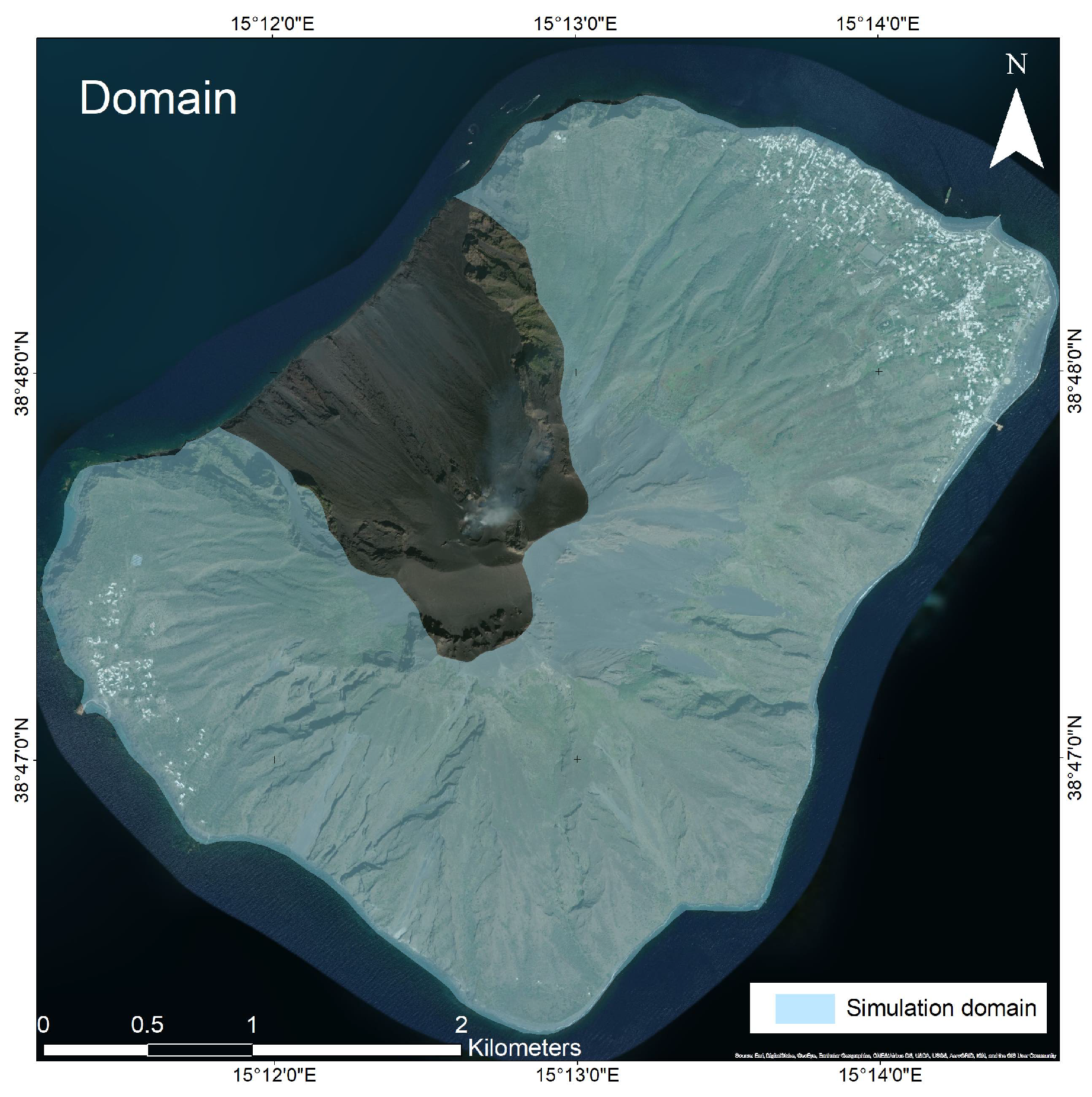
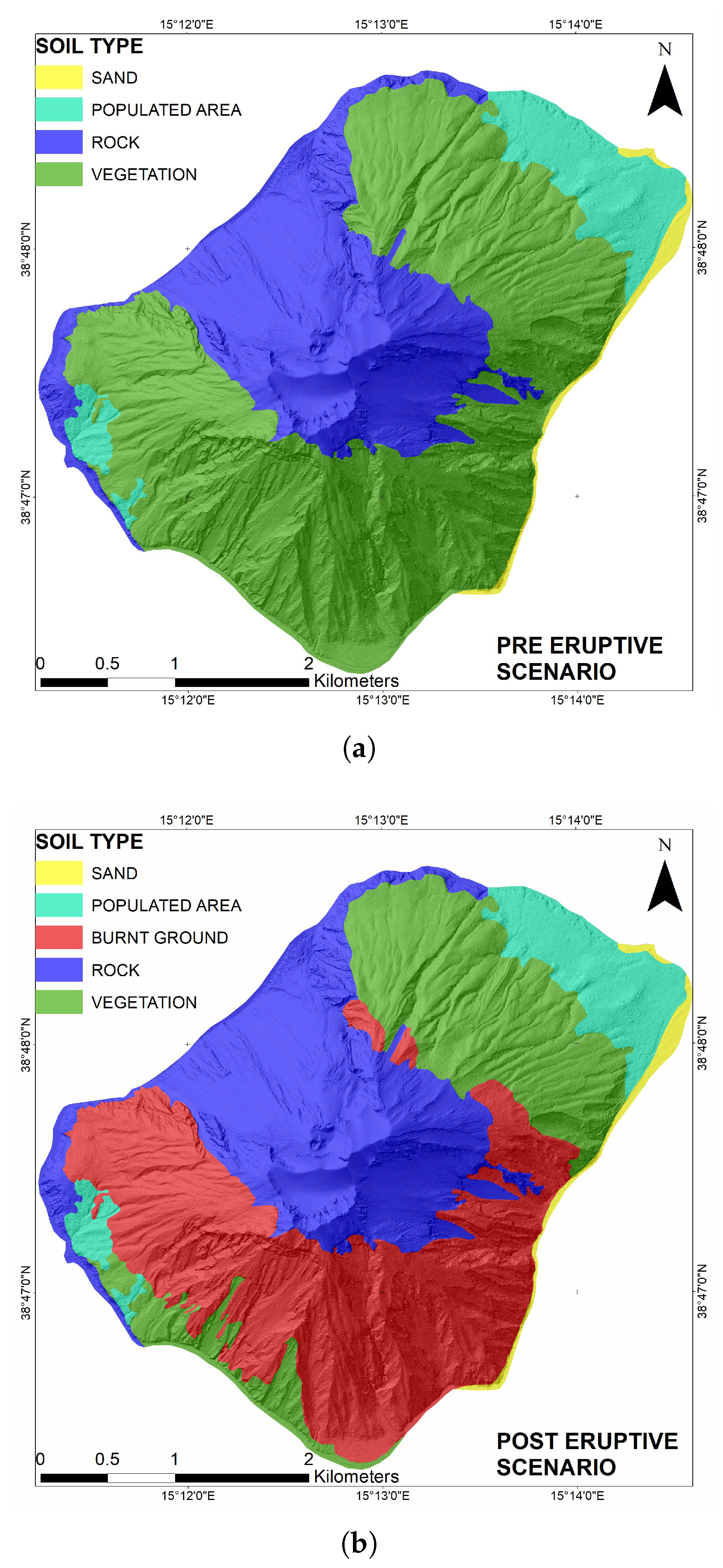


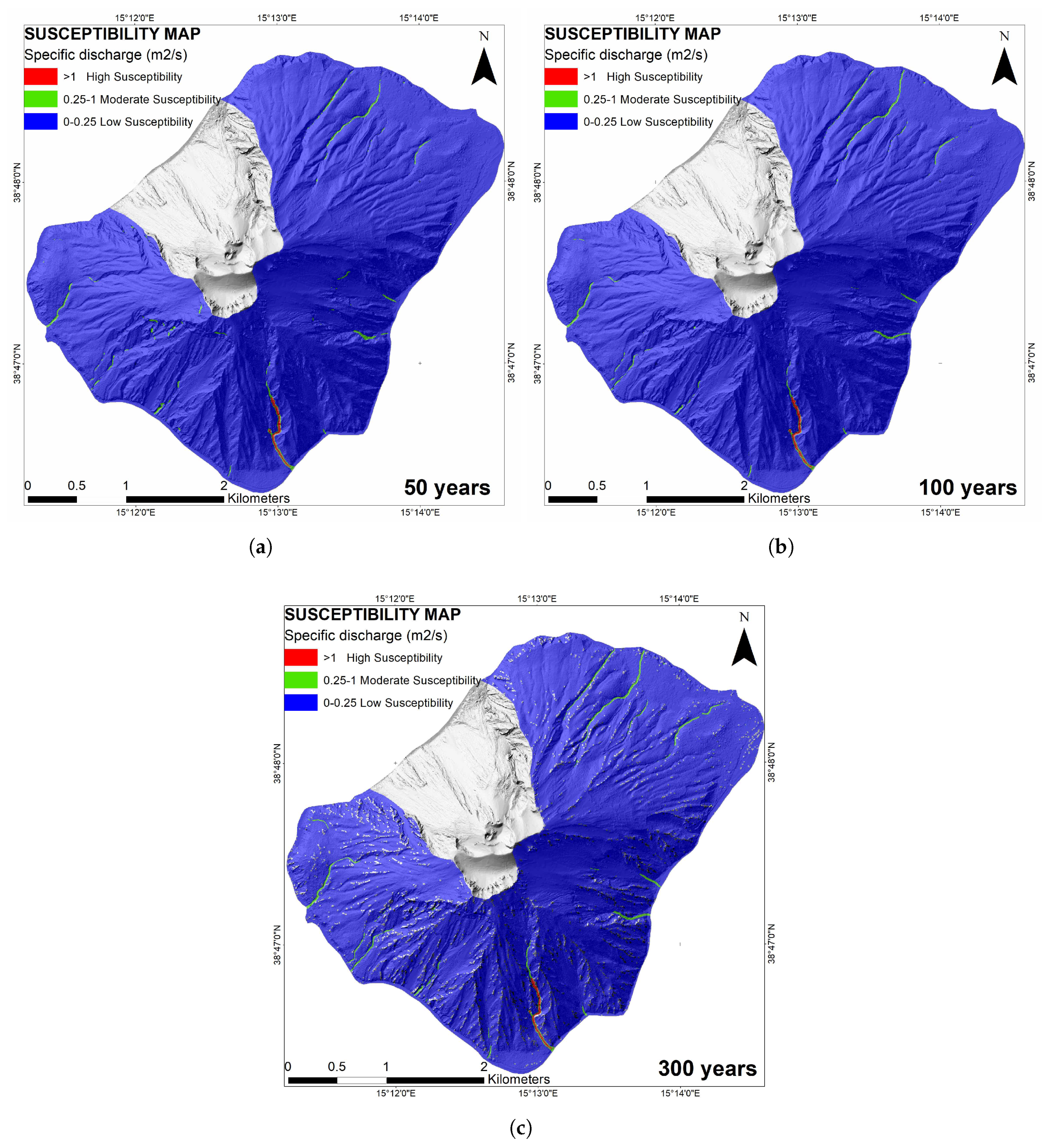


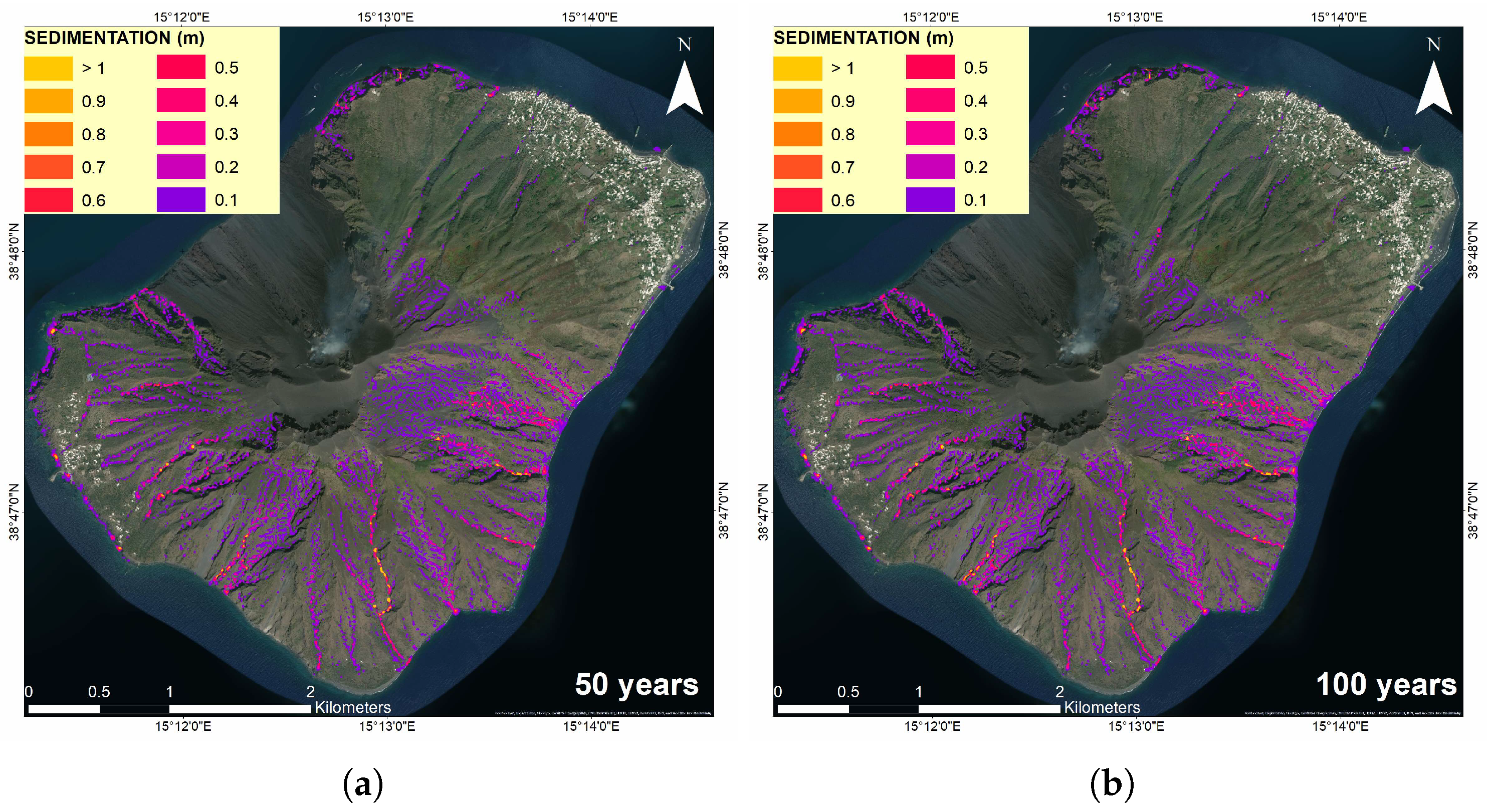
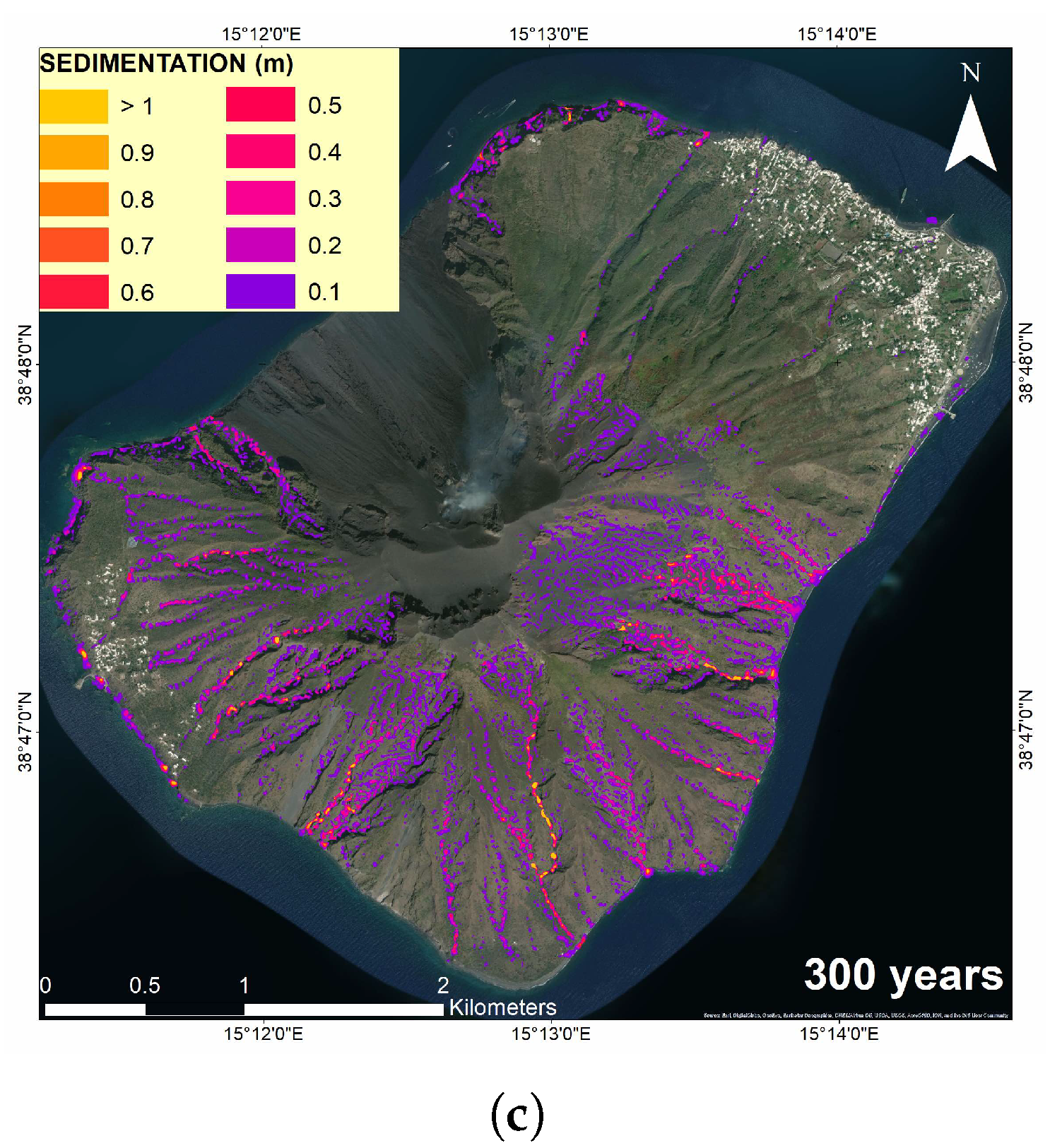
| (Years) | I (mm/h) | (mm/h) |
|---|---|---|
| 50 | 127.89 | 63.95 |
| 100 | 142.46 | 71.23 |
| 300 | 165.55 | 82.78 |
| Parameter | Value |
|---|---|
| Maximum simulation time | 1500 s |
| Results time interval | 12 s |
| Numerical scheme | First order |
| Courant–Friedrichs–Lewy number | 0.45 |
| Wet-dry limit | 0.01 m |
| Grain diameter | 0.0015 m |
| Bed porosity | 0.33 |
| Friction angle | 0.67 rad |
| Bed relative density | 2.65 |
© 2020 by the authors. Licensee MDPI, Basel, Switzerland. This article is an open access article distributed under the terms and conditions of the Creative Commons Attribution (CC BY) license (http://creativecommons.org/licenses/by/4.0/).
Share and Cite
Areu-Rangel, O.S.; Bonasia, R.; Di Traglia, F.; Del Soldato, M.; Casagli, N. Flood Susceptibility and Sediment Transport Analysis of Stromboli Island after the 3 July 2019 Paroxysmal Explosion. Sustainability 2020, 12, 3268. https://doi.org/10.3390/su12083268
Areu-Rangel OS, Bonasia R, Di Traglia F, Del Soldato M, Casagli N. Flood Susceptibility and Sediment Transport Analysis of Stromboli Island after the 3 July 2019 Paroxysmal Explosion. Sustainability. 2020; 12(8):3268. https://doi.org/10.3390/su12083268
Chicago/Turabian StyleAreu-Rangel, Omar S., Rosanna Bonasia, Federico Di Traglia, Matteo Del Soldato, and Nicola Casagli. 2020. "Flood Susceptibility and Sediment Transport Analysis of Stromboli Island after the 3 July 2019 Paroxysmal Explosion" Sustainability 12, no. 8: 3268. https://doi.org/10.3390/su12083268
APA StyleAreu-Rangel, O. S., Bonasia, R., Di Traglia, F., Del Soldato, M., & Casagli, N. (2020). Flood Susceptibility and Sediment Transport Analysis of Stromboli Island after the 3 July 2019 Paroxysmal Explosion. Sustainability, 12(8), 3268. https://doi.org/10.3390/su12083268









